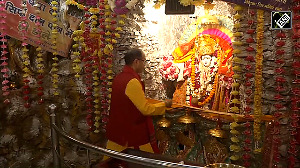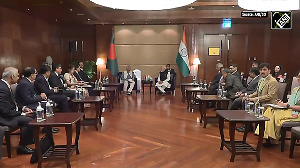Investments of over Rs 110,000 crore (Rs 1,100 billion) towards creating a new steel capacity of around 40 million tonnes for the country were announced in 2004.
Not just that, officials in the Union steel ministry have started talking of doubling India's steel production target from 100 million tonnes to 200 million tonnes by 2020.
Sceptics have been saying that the projects have been announced more with an eye on the country's ample iron ore reserves.
"The driver for growth is not India but China. It makes sense to dig for iron ore in India and sell it in China," said a steel industry source who did not wish to be named.
At the moment, this is a subject nobody is willing to discuss. The projects announced are ambitious and the numbers involved big. The big-ticket item was the interest shown by Posco of South Korea to set up a 10-million tonne steel plant in Orissa at a cost of $8 billion.
In between, it came to light that the company was also considering Brazil as a possible location for the proposed investment. Although the Orissa government went into overdrive to tie Posco down, the South Korean company is yet to make up its mind.
Others like the Steel Authority of India Ltd, Tata Steel, Essar Steel and Vedanta, too, announced their intention to invest in fresh steel capacity in Jharkhand and Orissa, close to the iron ore and coal deposits.
While their plans are still on the drawing board, Tata Steel picked up Singapore-based NatSteel for $486.4 million (Rs 1,313 crore (Rs 13.13 billion)) in an all-cash buyout. This will act as a beachhead for Tata Steel in the high-growth markets of China and Southeast Asia.
Through this transaction, Tata Steel has stretched its manufacturing footprint to seven new countries that include China, Thailand, Vietnam, the Philippines and Australia. The acquisition came with a 26 per cent equity in Southern Steel Berhad, a 1.3-million tonne Malaysian steelmaker.
The year also saw a cat-and-mouse game enacted between the government and the country's leading steel producers. Spiralling steel prices made the previous National Democratic Alliance government cut the import duty on a range of steel products in February.
A few days later, it cut the excise duty on steel from 16 per cent to 8 per cent and brought in another round of import duty cuts on raw materials like pig iron and coal.
Public sector companies like SAIL were told to make more steel available to the domestic market even if it meant lower exports. It was election time and the NDA government could hardly afford high steel prices.
In the beginning of March, the country's hot-rolled steel producers announced that they would roll back prices to Rs 25,000 per tonne and hold the priceline for six months.
The downstream users called it a hoax, alleging that prices had been raised just before the rollback. In effect, they said, the hot-rolled steel producers had actually raised their prices.
By August, the spectre of high steel prices had once again come to haunt the government, this time led by the United Progressive Alliance. High steel prices were seen driving inflation to very high levels.
In August, the government announced a fresh round of duty cuts on non-alloy steel (other than seconds and defectives), and ships for breaking and melting scrap of iron and steel (other than stainless steel or heat-resisting steel).
Tata Steel took the lead when Ratan Tata announced that the company would cut prices by Rs 2,000 per tonne. This caused some heartburn among other hot-rolled steel producers, though all of them announced some cuts in prices.
Still, the prices were seen as high. And if that was not enough, their traditional rivals, the downstream users, got together to lobby hard with the government. Over 1,000 secondary steel producers have come together to form a new lobby group called the Confederation of Indian Secondary Producers.







 © 2025
© 2025